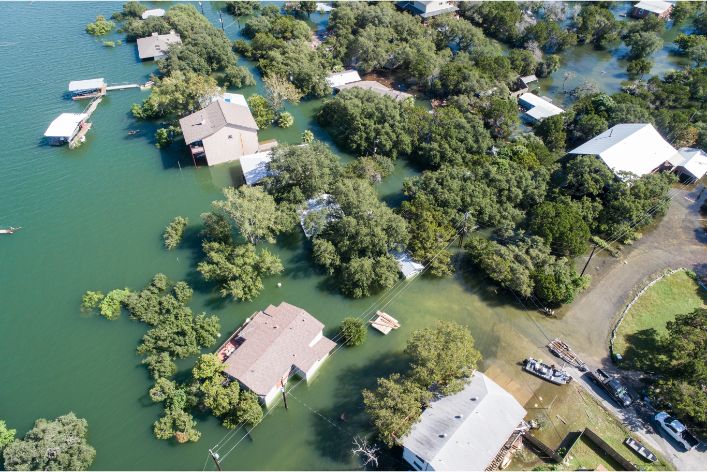Climate change is a phenomenon that has been affecting our planet for decades.
It is a long-term change in the Earth’s climate, including temperature, precipitation, and sea level rise.
The primary cause of climate change is the increase in greenhouse gases.
This traps heat in the Earth’s atmosphere and results in global warming.
Coastal properties refer to any real estate located near the coast, including homes, businesses, and infrastructure.
Coastal properties are highly susceptible to damage caused by rising sea levels, natural disasters, and erosion.
Many coastal communities rely heavily on these properties as a source of revenue and economic development.
Insurance costs for coastal properties are often higher due to the increased risk of damage caused by natural disasters and climate change.
Many insurance companies evaluate the potential risks associated with a property and set insurance rates accordingly.
Insurance costs can be extremely high in areas where natural disasters and climate change pose a significant threat.
This makes it difficult for homeowners and businesses to afford coverage.
Importance of Understanding Climate Change Impact on Coastal Properties and Insurance
Understanding the impact of climate change on coastal properties and insurance costs is crucial for individuals, businesses, and governments.
Recognizing the potential risks, we can proactively mitigate damage, reduce costs, and protect our communities.
This includes implementing strategies to reduce carbon emissions, investing in infrastructure to protect coastal properties, and working with insurance companies to develop affordable coverage options for those living in high-risk areas.
In the following sections, we will explore the impact of rising sea levels and natural disasters on coastal properties.
Innovative Tech Solutions, Tailored for You
Our leading tech firm crafts custom software, web & mobile apps, designed with your unique needs in mind. Elevate your business with cutting-edge solutions no one else can offer.
Start NowWe will also discuss the relationship between climate change and insurance costs, and potential solutions for property owners and communities.
By the end of this blog, you will better understand the challenges faced by coastal communities and the actions we can take to address them.
Read: 10 Questions to Ask Your Landlord Before Signing a Lease

Climate Change and Rising Sea Levels
A. Explanation of rising sea levels and its causes
Rising sea levels refer to the gradual increase in the average height of the Earth’s oceans.
This increase is primarily caused by thermal expansion and melting ice sheets and glaciers.
- Thermal Expansion: As the Earth’s atmosphere warms due to increasing greenhouse gas emissions, the ocean absorbs more heat, causing the water to expand and sea levels to rise.
- Melting Ice Sheets and Glaciers: As global temperatures continue to rise, ice sheets and glaciers in Greenland, Antarctica, and other parts of the world are melting at an unprecedented rate, contributing to sea level rise.
B. How rising sea levels affect coastal properties
Rising sea levels significantly impact coastal properties, resulting in increased flooding, erosion, and damage from storms and hurricanes.
- Flooding: As sea levels rise, coastal areas are more susceptible to flooding, both during high tides and severe weather events. This flooding can damage homes and infrastructure, contaminate water supplies, and impact local economies.
- Erosion: Higher sea levels also contribute to erosion, as waves and currents erode beaches and shorelines. This can result in the loss of coastal property, damage to infrastructure, and a decrease in tourism revenue.
- Storm Damage: Rising sea levels can exacerbate the damage caused by storms and hurricanes, as higher water levels increase the risk of flooding, erosion, and property damage.
C. Statistics on rising sea levels and coastal property damage
The impact of rising sea levels on coastal properties is already evident in many parts of the world, with numerous studies and reports highlighting the severity of the issue.
- According to the National Oceanic and Atmospheric Administration (NOAA), sea levels have risen approximately 8-9 inches since 1880, significantly increasing in recent decades.
- The Intergovernmental Panel on Climate Change (IPCC) estimates that global sea levels could rise by as much as 3 feet by the end of the century, with potentially catastrophic consequences for coastal communities.
- A study by the Union of Concerned Scientists found that nearly 300,000 U.S. homes are at risk of chronic flooding by 2045, with an estimated $117.5 billion in property damage.
- The same study found that by 2100, more than 2.4 million homes worth over $1 trillion could be at risk of chronic flooding.
- Coastal cities around the world are also facing significant risks, with a recent report by the Organization for Economic Cooperation and Development (OECD) estimating that $1 trillion in global assets are at risk from coastal flooding each year.
Rising sea levels pose a significant threat to coastal properties and communities around the world.
As such, we must take action to mitigate the impacts of climate change and protect vulnerable areas from the increasing risks posed by sea level rise.
Read: Eco-Wonder Homes Soar: Exciting Green Real Estate Movement
Natural Disasters and Coastal Properties
A. Explanation of natural disasters (hurricanes, floods, storms)
Natural disasters are events that occur due to natural phenomena, such as hurricanes, floods, and storms.
These events are often unpredictable and can cause significant damage to coastal properties.
- Hurricanes: These intense storms are characterized by strong winds, heavy rainfall, and storm surges, which can result in extensive flooding and property damage.
- Floods: Floods can occur due to heavy rainfall, storm surge, or other factors, and can cause significant damage to homes and infrastructure.
- Storms: Severe storms, such as nor’easters, can cause high winds, coastal erosion, and flooding, resulting in significant property damage.
B. How natural disasters affect coastal properties
Natural disasters can have a devastating impact on coastal properties, causing damage to homes, businesses, and infrastructure.
- Property Damage: Hurricanes and floods can cause extensive damage to homes and buildings, resulting in high repair costs and potential loss of property value.
- Business Disruption: Natural disasters can also disrupt local economies, particularly those that rely heavily on tourism and other coastal industries.
- Public Health Risks: Floods and other natural disasters can also pose significant risks to public health, including the spread of waterborne illnesses and other hazards.
C. Statistics on natural disasters and coastal property damage
The impact of natural disasters on coastal properties is evident in numerous studies and reports.
- According to the National Oceanic and Atmospheric Administration (NOAA), the cost of weather and climate disasters in the United States exceeded $95 billion in 2020, with hurricanes and wildfires among the costliest events.
- The same report found that 2020 had the most named storms on record, with many of these storms causing significant damage to coastal communities.
- A study by the National Bureau of Economic Research found that coastal homes are more vulnerable to hurricane damage than inland homes, with coastal properties experiencing an average of 36% more damage.
- The same study found that hurricanes can result in a significant decrease in property values, with coastal properties losing as much as 17% of their value in the year following a hurricane.
- According to a report by the Union of Concerned Scientists, sea level rise is expected to increase the frequency and severity of flooding, resulting in significant property damage in coastal communities.
The impact of natural disasters on coastal properties is a growing concern, and property owners and communities must take proactive steps to mitigate these risks.
By investing in infrastructure, developing emergency preparedness plans, and taking measures to reduce carbon emissions, we can work to protect coastal communities from the increasing threats posed by natural disasters.
Read: The Impact of Location on Real Estate Prices and Demand
Insurance Costs and Climate Change
A. Explanation of insurance costs and coverage for coastal properties
Insurance coverage for coastal properties is designed to protect homeowners and businesses from the financial losses associated with natural disasters and other risks.
Insurance costs are determined based on various factors, including the value of the property, the level of coverage needed, and the perceived risk of damage due to natural disasters and other events.
- Homeowners Insurance: Homeowners’ insurance policies typically cover damage caused by natural disasters, such as hurricanes, floods, and storms.
- Flood Insurance: Flood insurance is a separate policy covering damage caused by flooding, often excluded from traditional homeowners insurance policies.
B. How insurance companies determine coverage and rates
Insurance companies determine coverage and rates based on various factors, including the property’s location, the property, the age and condition of the property, and the perceived risk of damage due to natural disasters and other events.
- Risk Assessment: Insurance companies conduct risk assessments to determine the level of risk associated with insuring a particular property. This assessment takes into account factors such as the likelihood of natural disasters, the age and condition of the property, and the cost of repairs and replacement.
- Underwriting: Underwriting is the process by which insurance companies determine the coverage and rates for a particular policy based on the risk assessment.
- Premiums: Premiums are the amount paid by the policyholder to the insurance company in exchange for coverage. Premiums are determined based on the level of coverage needed, the perceived risk of damage, and other factors.
C. How climate change affects insurance costs for coastal properties
Climate change significantly impacts insurance costs for coastal properties, with rising sea levels and increased frequency and severity of natural disasters resulting in higher premiums and reduced coverage.
- Increased Risk: As the risk of damage due to natural disasters and other events increases, insurance companies are adjusting their coverage and rates to reflect this heightened risk.
- Reduced Coverage: In some cases, insurance companies may reduce coverage for properties in high-risk areas, making it more difficult for homeowners and businesses to obtain adequate coverage.
- Higher Premiums: Rising sea levels and increased risk of natural disasters are resulting in higher insurance premiums for coastal properties, making it more difficult for property owners to afford coverage.
- Mitigation Strategies: Some insurance companies are implementing mitigation strategies, such as offering discounts for properties that have implemented measures to reduce the risk of damage from natural disasters, such as installing hurricane shutters or elevating the property.
In summary, climate change is having a significant impact on insurance costs and coverage for coastal properties.
Insurance companies and property owners must work together to develop effective mitigation strategies as the risks associated with natural disasters and other events continue to increase.
They must ensure that adequate coverage is available for those living in high-risk areas.
Seamless API Connectivity for Next-Level Integration
Unlock limitless possibilities by connecting your systems with a custom API built to perform flawlessly. Stand apart with our solutions that others simply can’t offer.
Get StartedRead: 10 Useful Tips For First-Time Home Buyers

Solutions and Strategies for Coastal Property Owners
A. Explanation of potential solutions to mitigate damage and costs
Coastal property owners face unique challenges in protecting their homes and businesses from the risks associated with climate change and natural disasters.
However, several potential solutions can help mitigate damage and reduce costs.
- Invest in Infrastructure: Investing in infrastructure, such as seawalls and storm surge barriers, can help protect coastal properties from flooding and other damage caused by natural disasters.
- Implement Mitigation Measures: Property owners can implement measures to reduce the risk of damage from natural disasters, such as elevating the property, installing hurricane shutters, and reinforcing the roof.
- Work with Insurance Companies: Property owners can work with insurance companies to develop strategies to reduce premiums and ensure adequate coverage for their property.
B. Strategies for coastal property owners to reduce risk and costs
In addition to the potential solutions mentioned above, there are several strategies that coastal property owners can implement to reduce the risk and costs associated with climate change and natural disasters.
- Stay Informed: Property owners should stay informed about the risks associated with climate change and natural disasters in their area and take proactive measures to prepare for potential threats.
- Develop Emergency Plans: Property owners should develop emergency plans and evacuation procedures in the event of a natural disaster or other emergencies.
- Consider Retrofitting: Retrofitting existing properties with measures such as storm-resistant windows and doors, waterproofing, and flood barriers can help reduce damage and insurance costs.
- Support Community Resilience: Property owners should support community resilience efforts by participating in local planning efforts and advocating for infrastructure investments that benefit the entire community.
C. Importance of government and community involvement
Government and community involvement is crucial in addressing the challenges faced by coastal property owners.
- Government Support: Governments at all levels can provide support through grants, tax incentives, and other programs to encourage property owners to invest in infrastructure and implement mitigation measures.
- Community Involvement: Community involvement is critical in developing effective strategies to protect coastal properties from the risks associated with climate change and natural disasters. This includes participation in local planning efforts, supporting community resilience efforts, and advocating for government investment in infrastructure.
- Collaboration: Collaboration between property owners, government, and community stakeholders is essential in developing effective strategies and solutions to mitigate the impact of climate change on coastal properties.
Lastly, coastal property owners face significant risks associated with climate change and natural disasters.
However, by implementing potential solutions and strategies and involving government and community stakeholders, we can work together to mitigate damage, reduce costs, and protect our coastal communities.
Conclusion
Climate change significantly impacts coastal properties, resulting in increased risks and costs associated with natural disasters, rising sea levels, and other environmental factors.
Coastal property owners face unique challenges in protecting their homes and businesses from damage, while insurance companies are adjusting coverage and rates to reflect the heightened risk.
However, some potential solutions and strategies can help mitigate damage and reduce costs.
This includes investing in infrastructure, implementing mitigation measures, working with insurance companies, staying informed, developing emergency plans, and supporting community resilience efforts.
The impact of climate change on coastal properties and insurance costs is a growing concern, and we must take action to mitigate these risks.
By investing in infrastructure, implementing mitigation measures, and working with insurance companies, property owners can reduce the risk of damage and ensure adequate coverage.
Staying informed, developing emergency plans, and supporting community resilience efforts are also essential in protecting coastal communities from the increasing threats posed by climate change.
Collaboration between property owners, government, and community stakeholders is crucial in developing effective strategies and solutions to mitigate the impact of climate change on coastal properties.
Moreover, inaction could lead to catastrophic consequences for coastal communities, including damage to homes, businesses, and infrastructure and negative impacts on public health, tourism, and local economies.
Therefore, taking proactive steps to address the challenges coastal property owners face is vital to protecting our communities and securing a sustainable future for generations to come.
Before You Go…
Hey, thank you for reading this blog post to the end. I hope it was helpful. Let me tell you a little bit about Nicholas Idoko Technologies.
We help businesses and companies build an online presence by developing web, mobile, desktop, and blockchain applications.
We also help aspiring software developers and programmers learn the skills they need to have a successful career.
Take your first step to becoming a programming expert by joining our Learn To Code academy today!
Be sure to contact us if you need more information or have any questions! We are readily available.











